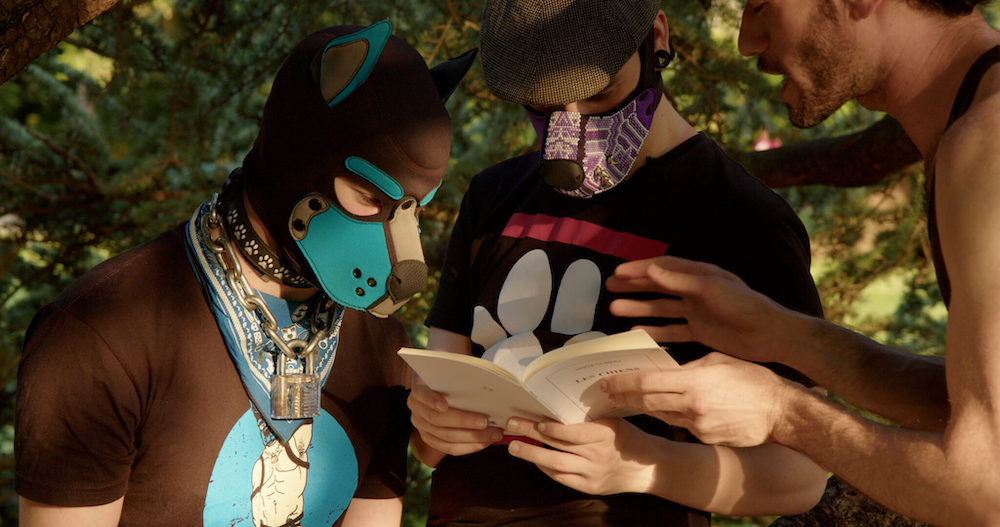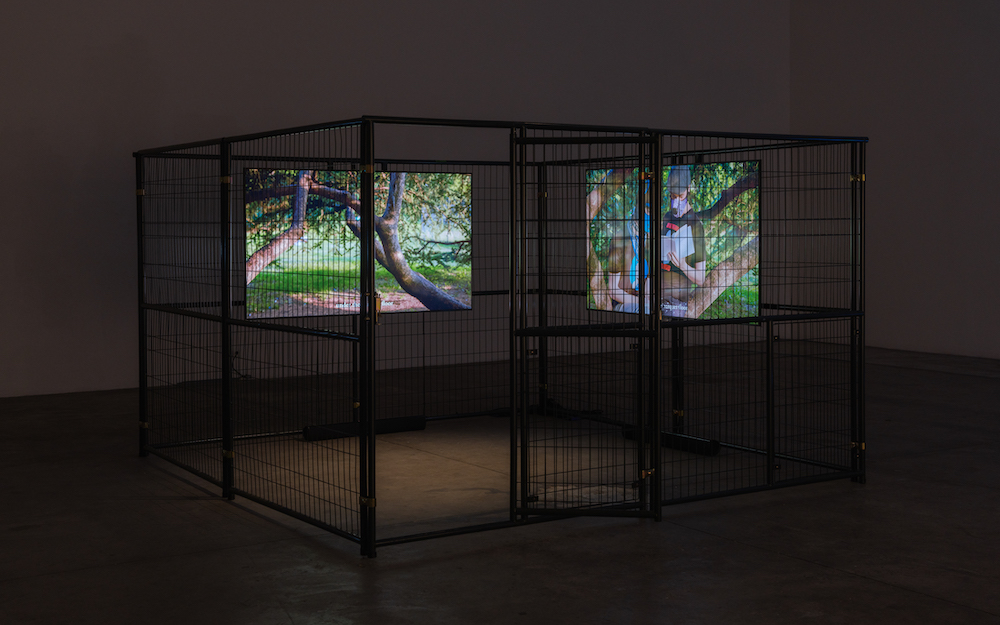On a rainy Saturday in early November, I spent the better part of an hour sitting cross-legged inside an XL dog crate. I did so in order to watch the screens mounted to the crate’s interior that broadcast Matthew Lax’s two-channel video, A TIRED DOG IS A GOOD DOG, PART TWO (2024), a video work from his ongoing project that is variously about queer “pup play,” dog training, and dog breeding. The video counterposes documentary footage of the artist interacting with “pups”—participants in a queer and BDSM-adjacent kink community of people dressed as dogs role-playing in dom/sub relationships—as well as his shadowing a professional trainer’s work with a real dog. Lax also includes a bit of archival footage from his own childhood as a quadruplet, which was spent on a farm, raised by parents who bred Collies. The video is one of a spare handful of video works spread throughout the gallery’s windowless interior; others include a monitor playing a 3D animation of a Collie doing a literary reading, and another with a succession of dog-related idioms flashing in white text on a black screen. Simple graphite drawings of dogs in various scenarios—fighting, peeing, wandering outside a sex club in Hollywood—line an adjacent wall.
I didn’t plan on watching 47 minutes of video art when I arrived at the gallery, but Lax’s work transfixed me. During my time in the crate, other viewers arrived and departed, some standing slightly outside the structure’s entrance or peering through the black wire while others tried to negotiate a comfortable standing position that didn’t involve leaning on unsupported walls. The makeshift theater struck me as an apt metaphor for the usual frustrations of seeing video art in a gallery: Who amongst art audiences doesn’t feel slightly caged trying to figure out how long the loop is going to run? The artist seems sensitive to such corollaries; not only to how the power dynamics between artist and viewer parallel those of human and animal, but also to the power dynamics between director and subject. To deal with this, Lax adopts a sort of “cinema verite lite” approach. The video is structured around a reading of French author Hervé Guibert’s Les Chiens, a 1982 erotic novella about a sadistic dom who chains two subs in dog masks. Lax doesn’t narrate, but he himself features heavily in the video work as a half-participant, half-observer. In one scene, he shadows the dog trainer on a hike with a rescue dog suffering from PTSD. In another, he leads a conversation with a circle of people in pup garb. Lax is gay but doesn’t identify as a pup himself; he’s an outsider navigating the usual problems of documentarians working with subjects whose worldviews differ from their own. To level the playing field and to make himself vulnerable, he strips down. While A TIRED DOG’s Pups wear masks, the artist appears on video unmasked, wearing only a jockstrap.

Matthew Lax, A TIRED DOG IS A GOOD DOG, PART TWO, 2024, video still. Photo: Matt Savitsky. Courtesy of the artist and Human Resources.
The best thing about Lax’s approach is that his primary subject, the taboo borderland of animal-human relations, is completely fascinating, and Lax gets out of the way of its most compelling aspects. He stays with his subjects in long shots, at one point fully allowing the professional dog trainer to explain aspects of his work with his traumatized canine pupil; at another, lingering on a roundtable conversation with the Pups about interpersonal relationships and “consensual dehumanization.” Watching A TIRED DOG felt, in some ways, like watching a fire—my mind went quiet, reaching back toward a kind of fundamental, evolutionary attention to animals and sex.
The worst thing about Lax’s approach is that it can verge on the overly academic. The premise of the work (the animations, drawings, wordplay video, a couple essay chapbooks, etcetera) comes out of poststructuralism, and to this end Lax casts a wide net, nimbly counterposing literary excerpts alongside brief anecdotes of personal experience, without ever arriving at a conclusion. Instead, he counts on meaning to emerge, and perhaps he’s correct. Perhaps meaning, like human consciousness, can emerge from context alone if you provide enough of it. I can see the appeal in backburnering something as problematic as a conclusive narrative voice. The issue is that I still have a subjective experience and a nagging voice in my own head, and I have to assume Lax does as well. I’d be curious to hear his voice more clearly, even with all its messiness and limits. Including that, I think, would be more vulnerable than getting naked on camera.


